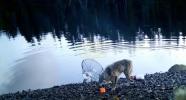

<A wolf along the central coast of British Columbia was recently captured on camera performing a sequence of actions strikingly similar to tool use—a behavior previously unseen in wild canids. The footage, taken in the territory of the Haíɫzaqv Nation and documented by researchers involved with the Haíɫzaqv Wolf and Biodiversity Project, shows the animal swimming out to a buoy attached to a submerged crab trap, dragging the buoy to shore, then pulling in the trap using the rope—and finally extracting and consuming the bait inside.
The trap-pulling incident occurred on May 29, 2024, and was recorded after local wardens noticed repeated damage to crab traps placed to control invasive species. Initially, investigators suspected marine predators such as seals or sea lions. However, motion-triggered cameras revealed a large female wolf carrying out the act.
According to the co-authors of the study published in the journal Ecology and Evolution, the behavior may represent the first documented case of tool use by a wild wolf—or at least a “complex, goal-directed behavior” far more sophisticated than previous observations.
The observed sequence involved multiple deliberate steps: retrieve buoy → drag buoy ashore → return for rope → haul in submerged trap → open netting → extract and consume bait. The wolves demonstrated confidence, efficiency, and what researchers described as a clear understanding of cause and effect.
Not all scientists agree that the behavior qualifies strictly as “tool use.” Some argue that because the wolf did not manufacture or reconfigure the tool (the trap) itself but rather manipulated a part (the buoy/rope) that someone else placed, this may not meet the classic definition. Others counter that using an external object to achieve a goal should count—and that this event reveals far greater cognitive flexibility in wolves than previously acknowledged.
Regardless of semantics, the discovery challenges long-held assumptions about wild canid behavior. The coastal environment—where wolves live under relatively low human pressure—may have allowed them the time and safety to experiment, learn, and adopt novel behaviors. This finding opens new avenues for research on animal intelligence, adaptability, and how human-made objects influence wildlife.
In short—a wolf in British Columbia may have just rewritten what we thought wild wolves were capable of. Whether we call it “tool use” or “clever improvisation,” the footage speaks: wild wolves are more versatile and observant than we’ve ever given them credit for.
גאלערי
ווידעאס